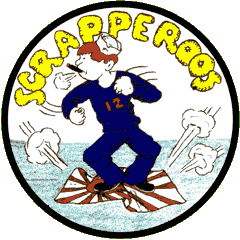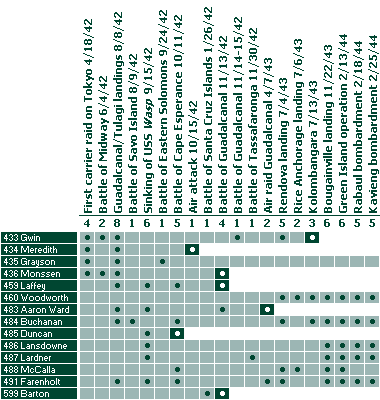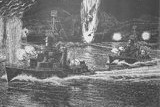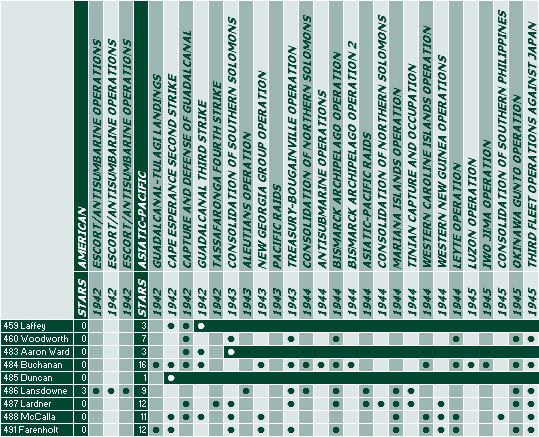

In mid-1942, fourteen ships of the Navy’s newest class of destroyer were assigned to the Pacific in two groups—the four ships of Destroyer Division 22 arriving together from Destroyer Squadron 11 in the Atlantic; nine ships of new construction following in ones and twos, later organized as Destroyer Squadron 12. It did not take long before sinkings led to reorganization. Today, shipmates speak of this entire group as DesRon 12 or invoke its later nickname, the “Scrapperoos.”

DesDiv 22 & DesRon 12 actions in the Pacific, April 1942–February 1944.
Twenty-four “flat-stack” Bethlehem Steel-designed Bensons and “round-stack” Gibbs & Cox-designed Gleaves were authorized through FY 1940. Commissioned by early 1941, they were assigned to Destroyer Squadrons 7, 11 (Destroyer Divisions 21 and 22) and 13 serving in the Atlantic. While twenty of these remained in the European theater through most or all of World War II, however, the four Gleaves of DesDiv 22, Gwin, Meredith, Grayson and Monssen—all commissioned mid-January to mid-March 1941—were redeployed in early 1942 to the Pacific. On arrival, they superseded the Sims-class ships of DesRon 2 as the most modern destroyers in the theater. In their first assignment, the four—with cruisers Vincennes and Nashville and oiler Cimarron—formed the escort for Hornet‘s Task Force 18 in Lieutenant Colonel “Jimmy” Doolittle’s raid on Japan in April; Gwin and Monssen were also present at the Battle of Midway in June.
Meanwhile, in December 1940, the Navy authorized construction of “repeat” Bensons and Gleaves—the Bristol class. The second squadron of these ships after DesRon 10, and the US Navy’s fifth squadron of 1,620- and 1,630-tonners, were flat-stacks Laffey, Woodworth and Farenholt and six consecutively-numbered round-stacks from Federal: Aaron Ward, Buchanan, Duncan, Lansdowne, Lardner and McCalla, all commissioned March–May 1942.
Following shakedown, these Bristols went directly to the Pacific. Farenholt joined DesDiv 15 (Lang, Stack, Sterett and Wilson) in escorting Wasp (CV 7) from the Atlantic. Aaron Ward, Buchanan, Laffey, Duncan, Lansdowne and Lardner arrived in time to operate with the Wasp task force and, less Buchanan, were with her when she sank 15 September. Collectively, they comprised most of the first ships of their class to arrive in the SoPac after DesDiv 22. Initially with Laffey as flagship, by October they had formed Destroyer Squadron 12 in the South Pacific with Farenholt as flagship. Often operating with them was Barton, which was never administratively attached to a squadron.
The combined records of these fourteen destroyers in 1942 mirrored the Guadalcanal campaign, which commenced in early August. At least one of them was present at all seven named engagements and five ships were lost: Duncan at the Battle of Cape Esperance 11–12 October, Meredith sacrificed in an overwhelming air attack on the 15th, and Monssen, Laffey and Barton with Task Force 67 at the Battle of Guadalcanal, 12–13 November.

Scrapperoos attack Rabaul by Lansdowne Ensign Dan Teis.
In 1943, after Gwin and Grayson were absorbed into the squadron, Aaron Ward was lost in April, followed by Gwin at the Battle of Kolombangara in July, reducing the original number of ships in half, to seven.
Throughout the New Georgia and Bougainville operations into 1944, even as the larger Fletcher-class 2,100-tonners of squadrons 21, 22, 23 and 45 arrived, Grayson, Woodworth, Buchanan, Lansdowne, Lardner, McCalla and Farenholt continued operating in a full range of escort, anti-shipping, anti-submarine and shore bombardment assignments. Buchanan remained in the theater for nearly 20 months (August 1942–late March 1944), a tour that outlasted the entire Solomon Islands phase of the war.
DesRon 12 operations reached a climax in offensive raids, February 1944. Assigned to missions paralleling those of Capt. Arleigh Burke’s newly-famous “Little Beavers” (and later, DesRons 45 and 22), Farenholt, Buchanan, Woodworth, Lardner and Lansdowne penetrated the Bismarck Archipelago in back-to-back weeks, attacking Rabaul’s Karavia Bay and Simpson Harbor and Kavieng (where Farenholt and Buchanan were hit by shore battery fire), then steaming triumphantly home to Purvis Bay with a new nickname honoring their own commodore—“Simpson’s Solomons Scrappers,” later the “Scrapperoos.”
Their collective turn for West Coast refit finally came in the spring of 1944, when the squadron was reorganized. Buchanan was detached and reassigned to Destroyer Division 37, where she joined Stevenson, Stockton and Thorn; Grayson, the lone survivor of DesDiv 22, was reassigned to DesDiv 24 and joined by the three survivors of DesDiv 26, which transferred from the Atlantic in January.
The remaining five ships, Farenholt, Woodworth, Lansdowne, Lardner and McCalla continued on as DesDiv 23, normally screening carriers. In different combinations, they were assigned to the assault on Guam, 21 July–10 August, strikes on Palau and the Philippines, and on 14 September became the first ships to close the Philippines for shore bombardment. After landings at Morotai and Palau and an overhaul, they rejoined the war at Okinawa in 1945 and operated with the Third Fleet against Japan in the summer.
Their final assignment came again from Adm. Halsey. For the parade into Tokyo Bay, 29 August 1945, Lansdowne and Lardner—reunited with Buchanan—were ordered to form the escort for Adm. Nimitz’s flagship South Dakota. Four days later, Buchanan embarked General MacArthur and his party for the surrender ceremony on board Missouri and Lansdowne transported the Japanese delegation. Elsewhere, Farenholt accepted the surrender of islands in the southern Ryukyus and in the Sakishima Gunto.
